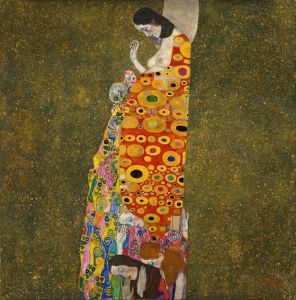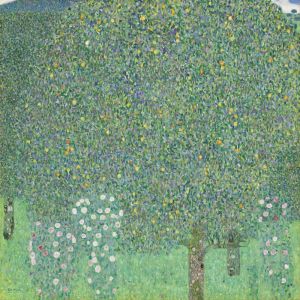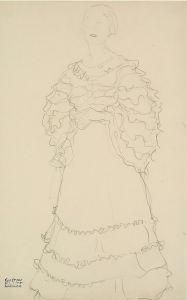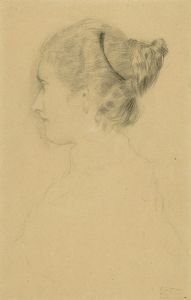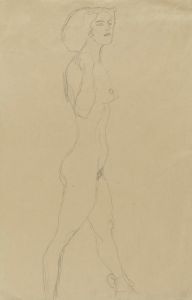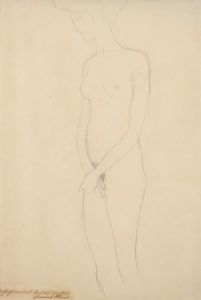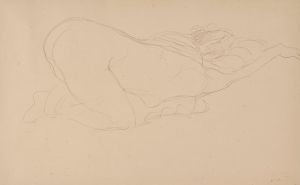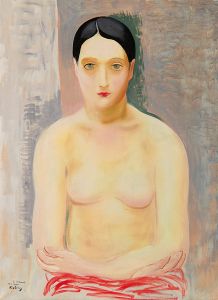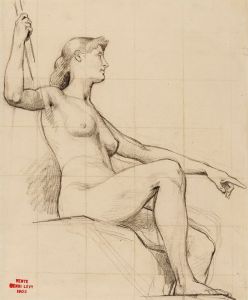
Zusammengekauerter Halbakt
A hand-painted replica of Gustav Klimt’s masterpiece Zusammengekauerter Halbakt, meticulously crafted by professional artists to capture the true essence of the original. Each piece is created with museum-quality canvas and rare mineral pigments, carefully painted by experienced artists with delicate brushstrokes and rich, layered colors to perfectly recreate the texture of the original artwork. Unlike machine-printed reproductions, this hand-painted version brings the painting to life, infused with the artist’s emotions and skill in every stroke. Whether for personal collection or home decoration, it instantly elevates the artistic atmosphere of any space.
Gustav Klimt, an Austrian symbolist painter, is renowned for his distinctive style that often combines elaborate patterns with erotic and allegorical themes. One of his lesser-known works is "Zusammengekauerter Halbakt," which translates to "Crouching Half-Nude." This artwork is a part of Klimt's extensive exploration of the female form, a subject that dominated much of his oeuvre.
Klimt was born in 1862 in Baumgarten, near Vienna, and became one of the most prominent members of the Vienna Secession movement. His work is characterized by a unique blend of symbolism and Art Nouveau, often incorporating gold leaf and intricate patterns. While Klimt is best known for masterpieces such as "The Kiss" and "Portrait of Adele Bloch-Bauer I," his studies and sketches, including "Zusammengekauerter Halbakt," offer insight into his artistic process and thematic interests.
"Zusammengekauerter Halbakt" is a drawing that exemplifies Klimt's fascination with the human body, particularly the female form. The artwork features a woman in a crouched position, partially nude, which is a recurring motif in Klimt's work. This piece highlights Klimt's skill in capturing the subtleties of human anatomy and emotion through minimalistic yet expressive lines. The drawing is executed with a delicate touch, emphasizing the contours and posture of the figure, which conveys a sense of vulnerability and introspection.
Klimt's approach to the female form was often considered controversial during his time, as it challenged the conservative norms of the late 19th and early 20th centuries. His depictions of women were not merely aesthetic; they were imbued with a sense of empowerment and complexity. Klimt's work often blurred the lines between eroticism and art, inviting viewers to explore the deeper psychological and emotional layers of his subjects.
The Vienna Secession, of which Klimt was a founding member, was an art movement that sought to break away from traditional academic art. It embraced modernism and encouraged artists to explore new forms and ideas. Klimt's work, including "Zusammengekauerter Halbakt," reflects this ethos, as he continuously pushed the boundaries of artistic expression.
While "Zusammengekauerter Halbakt" may not be as widely recognized as some of Klimt's other works, it remains an important piece within his body of work. It provides a glimpse into the artist's ongoing exploration of form, emotion, and the human experience. Klimt's ability to convey complex themes through simple yet powerful imagery is evident in this drawing, making it a valuable study for those interested in his artistic journey.
In summary, "Zusammengekauerter Halbakt" is a testament to Gustav Klimt's mastery of line and form, as well as his commitment to exploring the depths of human emotion and identity. Through this piece, Klimt continues to captivate audiences with his unique vision and enduring influence on the world of art.






